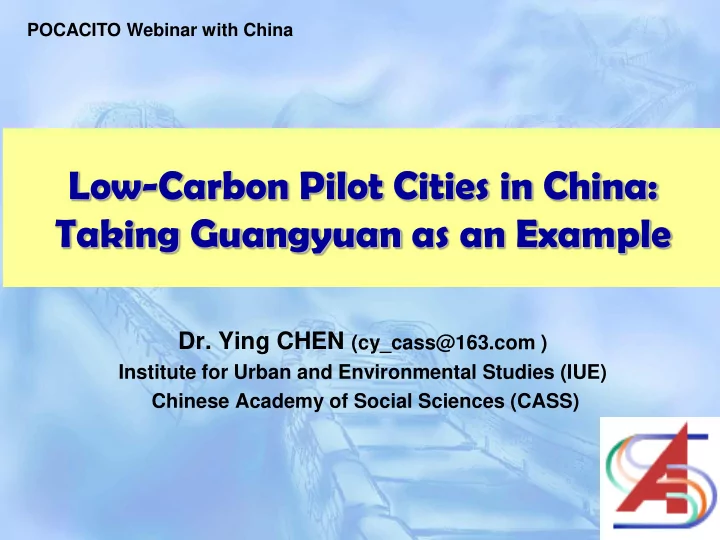

POCACITO Webinar with China Low-Carbon Pilot Cities in China: Taking Guangyuan as an Example Dr. Ying CHEN (cy_cass@163.com ) Institute for Urban and Environmental Studies (IUE) Chinese Academy of Social Sciences (CASS)
Content Brief Introduction to China’s Climate Change Policy Urbanisation Process and Potential Impacts on Carbon Emissions Low-Carbon City Pilot and Demonstration Programme Case Study in Guangyuan
China’ s Intended Nationally Determined Contributions (INDC) To achieve the peaking of CO 2 emissions around 2030 and making best efforts to peak early; To lower CO 2 emissions per unit of GDP by 60% to 65% from the 2005 level; To increase the share of non-fossil fuels in primary energy consumption to around 20%; To increase the forest stock volume by around 4.5 billion cubic meters on the 2005 level.
Achievement made by 2014 CO 2 emissions per unit of GDP is 33.8% lower than the 2005 level; The share of non-fossil fuels in primary energy consumption is 11.2%; The installed capacity of hydro power is 300 gigawatts (2.57 times of that for 2005); The installed capacity of on-grid wind power is 95.81 gigawatts (90 times of that for 2005); The installed capacity of solar power is 28.05 gigawatts (400 times of that for 2005); and The installed capacity of nuclear power is 19.88 gigawatts (2.9 times of that for 2005). The forested area and forest stock volume are increased respectively by 21.6 million hectares and 2.188 billion cubic meters compared to the 2005 levels;
Policies and Measures to Implement INDCs Implementing Proactive National Strategies on Climate Change Improving Regional Strategies on Climate Change Building a Low-Carbon Energy System Building an Energy Efficient and Low-Carbon Industrial System Controlling Emissions from Building and Transportation Sectors Increasing Carbon Sinks Promoting the Low-Carbon Way of Life Enhancing Overall Climate Resilience Innovating Low-Carbon Development Growth Pattern Enhancing Support in terms of Science and Technology Increasing Financial and Policy Support Promoting Carbon Emissions Trading Market Improving Statistical and Accounting System for GHG Emissions Broad Participation of Stakeholders Promoting International Cooperation on Climate Change
Innovating Low-Carbon Development Growth Pattern To advance low-carbon pilots in provinces and cities; To conduct low-carbon cities (towns) pilots as well as low-carbon industrial parks, low-carbon communities, low-carbon business and low-carbon transport pilots; To explore diversified patterns of low-carbon growth; To research on effective approaches to control carbon emissions in different regions and cities; ……
Urbanization Process in China Urbanization rate was about 54% in 2014 and is estimated to go up to 70% in 2030. Urbanization rate rural urban WB,2012
Potential Impacts of Urbanization on Carbon Emissions IEA estimated that Urban area consumes 67% of total energy and is responsible for over 70% of emissions Large number of migrants Public service: large scale infrastructure construction demands for heavy industry Housing: about 60bm 2 stock of existing buildings and 1.8bm 2 of new residential buildings built annually Employment pressure Lifestyle changed: more electronic appliances Energy mix: biomass to commercial energy Environmental impacts including carbon emissions ……
International Comparison of Urbanization and Carbon Emissions China Emissions intensity 50%-90% Emissions 55%-95% per capita Total Emissions similar with peak of emissions per capita except some countries Urbanization rate
Can China Find Low Carbon Development Pathways in Provinces and Cities? Low-Carbon City Pilot Programme: The First batch: 5 provinces + 8 cities (July 2010) The Second batch: 1 + 28 including Beijing, Shanghai, Guangyuan and etc. (Dec. 2012)
Recent Progress in Low-carbon Pilots and Demonstration Of 42 pilot provinces and cities, 13 established low-carbon development funds 36 developed carbon reduction target decomposition and assessment mechanisms All have clearly put forward peak targets or are studying the issue, and the peak year proposed is 2025 or before. U.S.-China Climate Leaders Declaration On the Occasion of the First Session of the U.S.-China Climate-Smart/Low-Carbon Cities Summit (Los Angeles, Sept. 15-16th 2015)
Basic information of Guangyuan City GY located in northern Sichuan Province, south-western of China, consisting of 3 districts and 4 counties with a long history. 16.3 thousand km 2 and 3.14 million population GY is the only low-carbon city pilot in Sichuan Province, also known as an excellent tourist city, national forestry city, national sanitary city. GY developed rapidly after “5.12” earthquake in 2008.
Reach 30% target of 12 th Five Year Plan ahead of time CO 2 /GDP reduced by 33.4% below 2010 level in 2014. CO 2 per capita is less than 1.5 tons. Energy consumption per unit of industrial value-added for large scale enterprises (tce/10000RMB) CO 2 /GDP (tCO 2 /10000RMB) Energy use/GDP (tce/10000RMB)
Structural Adjustment Energy use growth (2006-2013) Characteristic agriculture Strategic emerging industry Coal NG Oil Power Service (tourism, leisure activities, etc.) service Non-fossil fuel is 23.36% of industry energy mix Natural gas 180million m 3 /y agriculture methane from biomass (75% users in rural area) Hydro power 2.15 Gigawatts Other renewable energy 0.19Gigawatts
Transportation and Buildings Public buildings retrofitted and managed to reduce energy use per m 2 by 3.2%, energy use per capita by 4% Green buildings pilot 2 projects Low-carbon pilot communities 12 (city level) and 24 (county level) Public transportation system including 150km special “green lane” for riding bicycle and hiking, 1000 bicycles for free, 6300 natural gas bus, etc.
Carbon Sinks Forestry coverage was about 54.6% in 2014, 2.3 percentage higher than in 2010. It is estimated that forestry can absorb 24.1 million tonnes in 2010, which is about 4.5 times of carbon emissions from fossil fuel.
Institutional Construction and Capacity Building Low-carbon Bureau as leading group Inventory of GHGs emission (2010 base year) Guidelines for low-carbon industrial park and community Carbon reduction target decomposition and low carbon assessment indicators for districts and counties Cooperation with institutes, universities and NGOs Training and education to raise the public awareness for low carbon lifestyle, for example, Low-Carbon Day initiated 5 years ago, 3 years before the central government; low-carbon information website; annual report on low-carbon city pilot, etc.
Recommend
More recommend